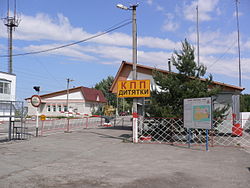Chernobyl Nuclear Power Plant Zone of Alienation
Зона відчуження Чорнобильської АЕС | |
|---|---|
 Entrance to the Zone of Alienation at Dytiatky, 2010 | |
 Map showing the "30-Kilometre Zone" (red) around the Chernobyl Nuclear Power Plant and the Polesie State Radioecological Reserve (orange) in neighbouring Belarus | |
| Coordinates: 51°18′00″N 30°00′18″E / 51.3°N 30.005°E | |
| Country | |
| Oblasts | Kyiv Oblast Zhytomyr Oblast (de jure)[1] |
| Raion | Vyshhorod Raion |
| Founded | 27 April 1986 |
| Area | |
• Total | 2,600 km2 (1,000 sq mi) |
| Population (2016) | |
• Total | 180 samosely[2] For others: the Zone of Alienation is an "Area of Absolute (Mandatory) Resettlement" and employees of state agencies are residents on a temporary basis.[3][4] |
| Time zone | UTC+2 (EET) |
| • Summer (DST) | UTC+3 (EEST) |
| Website | dazv.gov.ua |

The Chernobyl Nuclear Power Plant Zone of Alienation,[a] also called the 30-Kilometre Zone or simply The Zone,[5]: p.2–5 [b] was established shortly after the 1986 Chernobyl disaster in the Ukrainian SSR of the Soviet Union.[5]: p.4–5 : p.49f.3
Initially, Soviet authorities declared an exclusion zone spanning a 30-kilometre (19 mi) radius around the Chernobyl Nuclear Power Plant, designating the area for evacuations and placing it under military control.[6][7] Its borders have since been altered to cover a larger area of Ukraine: it includes the northernmost part of Vyshhorod Raion in Kyiv Oblast, and also adjoins the Polesie State Radioecological Reserve in neighbouring Belarus. The Chernobyl exclusion zone is managed by an agency of the State Emergency Service of Ukraine, while the power plant and its sarcophagus and the New Safe Confinement are administered separately.
The current area of approximately 2,600 km2 (1,000 sq mi)[8] in Ukraine is where radioactive contamination is the highest, and public access and habitation are accordingly restricted. Other areas of compulsory resettlement and voluntary relocation not part of the restricted exclusion zone exist in the surrounding areas and throughout Ukraine.[9] In February 2019, it was revealed that talks were underway to re-adjust the exclusion zone's boundaries to reflect the declining radioactivity of its outer areas.[10]
Public access to the exclusion zone is restricted in order to prevent access to hazardous areas, reduce the spread of radiological contamination, and conduct radiological and ecological monitoring activities.[11] Today, the Chernobyl exclusion zone is one of the most radioactively contaminated areas on Earth and draws significant scientific interest for the high levels of radiation exposure in the environment, as well as increasing interest from disaster tourists.[12][13] It has become a thriving sanctuary, with natural flora and fauna and some of the highest biodiversity and thickest forests in all of Ukraine. This is primarily due to the lack of human activity in the exclusion zone since 1986, in spite of the radioactive fallout.[14]
Since the beginning of the Russian invasion of Ukraine in February 2022, the Chernobyl exclusion zone has been the site of fighting with neighbouring Russia, which captured Chernobyl on 24 February 2022. By April 2022, however, as the Kyiv offensive failed, the Russian military withdrew from the region.[15] Ukrainian authorities have continued to keep the exclusion zone closed to tourists, pending the eventual cessation of hostilities in the Russo-Ukrainian War.
- ^ Zhytomyr Oblast with its Korosten Raion includes several villages that were evacuated after the Chernobyl disaster, but never became a part of the administrative exclusion zone, which only covers the northern part of Kyiv Oblast's Vyshhorod Raion
- ^ Hjelmgaard, Kim. "Why a babushka in Chernobyl Exclusion Zone refuses to leave home". USA TODAY.
- ^ "Чернобыльскую зону "захватывают" самоселы". Ura-inform.com. 28 August 2012. Retrieved 22 October 2012.
- ^ "Секреты Чернобыля - "Самоселы"". Chernobylsecret.my1.ru. Retrieved 22 October 2012.
- ^ a b Petryna, Adriana (2002). Life Exposed: Biological Citizens after Chernobyl. New Jersey: Princeton University Press. ISBN 978-0-691-09019-1.
- ^ Marples, David R. (1988). The Social Impact of the Chernobyl Disaster. New York: St. Martin's Press. ISBN 978-0-312-02432-1.
- ^ Mould, R. F. (2000). Chernobyl Record: The Definitive History of the Chernobyl Catastrophe. Bristol, UK: Institute of Physics Publishing. ISBN 978-0-7503-0670-6.
- ^ Cite error: The named reference
Oskolkovetalwas invoked but never defined (see the help page). - ^ "Zoning of radioactively contaminated territory of Ukraine according to actual regulations". ICRIN. 2004. Archived from the original on 18 February 2013. Retrieved 25 April 2012.
- ^ Chernobyl: The end of a three-decade experiment BBC News. 14 February 2019. Retrieved 15 February 2019.
- ^ "Decree of the President of Ukraine No. 393/2011 On approval of the State Agency of Ukraine of the Exclusion Zone". State Agency of Ukraine on Exclusion Zone Management. 6 April 2011. Archived from the original on 3 December 2013. Retrieved 23 April 2012.
- ^ "Postcard from hell". The Guardian. 18 October 2004. Archived from the original on 28 October 2017. Retrieved 25 April 2012.
- ^ Canales, Katie. "A photographer visited the abandoned towns around Chernobyl more than 20 times over the past 25 years, and the captivating photos show just how suddenly time stopped in its tracks after the disaster". Business Insider.
- ^ "How Chernobyl has become an unexpected haven for wildlife". UNEP. 16 September 2020.
- ^ Cite error: The named reference
DohertySaricwas invoked but never defined (see the help page).
Cite error: There are <ref group=lower-alpha> tags or {{efn}} templates on this page, but the references will not show without a {{reflist|group=lower-alpha}} template or {{notelist}} template (see the help page).

